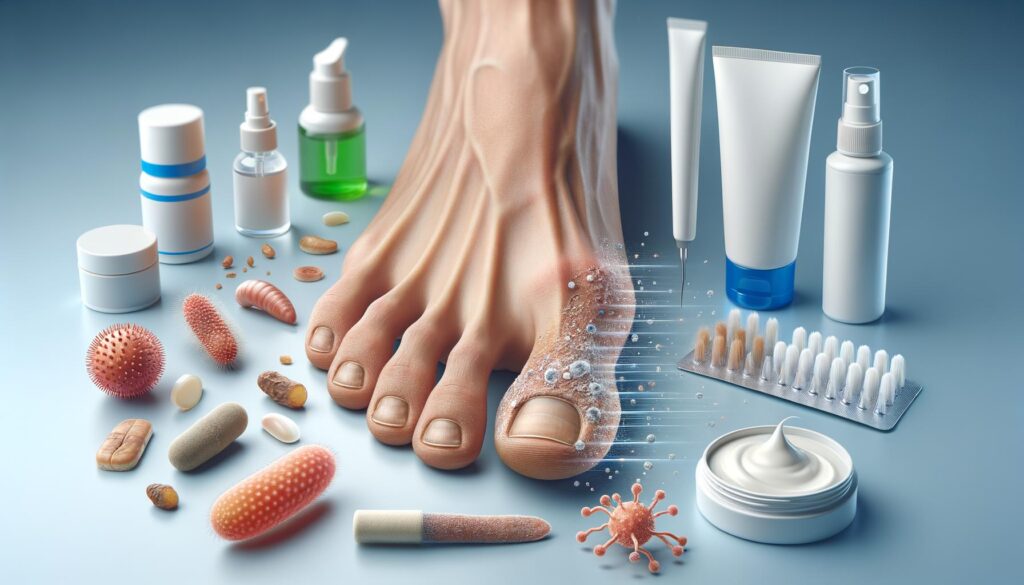Effective Strategies for Managing Toenail Fungus

Understanding Toenail Fungus
Toenail fungus, medically known as onychomycosis, is a common condition that can affect one or multiple toenails. This fungal infection is characterized by thickened, discolored, and brittle nails, often accompanied by an unpleasant odor. It thrives in warm and moist environments, making the feet an ideal host. Understanding the causes and symptoms is key to addressing the issue effectively. Typically, the infection begins as a white or yellow spot under the tip of your toenail. As it penetrates deeper, it may cause your nail to discolor, thicken, and develop crumbling edges. Common causes include contact with fungal agents in communal areas like showers, pools, and locker rooms, as well as wearing tight-fitting shoes that create a damp environment. Those with existing conditions like diabetes or a weakened immune system are more susceptible, making prevention and treatment all the more crucial.
Home Remedies and Natural Treatments
If you’re seeking to tackle toenail fungus at home, there are several natural remedies that can offer relief. While they may not guarantee a complete cure, they can help manage symptoms and potentially halt the spread of the fungus. Here are some popular options:
- Tea Tree Oil: Known for its antifungal properties, applying diluted tea tree oil can aid in reducing infection.
- Vinegar Soak: Soaking feet in a vinegar and water solution is believed to balance pH levels and inhibit fungal growth.
- Garlic: With antifungal compounds, crushed garlic can be applied to the nail or added to a warm foot bath.
- Coconut Oil: Its fatty acids have antifungal properties, making coconut oil a gentle option to apply on the nails.
Remember, consistency is crucial with these treatments. It’s recommended to continue applying until the fungus shows visible signs of improvement.
Over-The-Counter Treatments
While home remedies can be effective, over-the-counter (OTC) antifungal treatments are formulated specifically for toenail fungus. These treatments come in the form of creams, lotions, sprays, and nail lacquers, making them a convenient option for many. The key ingredient in many OTC products is undecylenic acid or clotrimazole, which are potent antifungal agents. Here’s how you can incorporate OTC treatments into your routine:
- Clean the affected area thoroughly before application to ensure maximum absorption.
- Follow the product instructions carefully regarding the amount and frequency of application.
- Pair with good foot hygiene practices, like wearing breathable socks and keeping nails trimmed.
These treatments often show noticeable results after several weeks of consistent use. Be patient and persistent, as toenail fungus can be particularly stubborn.
When to Consult a Healthcare Professional
If over-the-counter treatments and home remedies fail to produce results, it may be time to speak with a healthcare professional. In particular, seek medical attention if:
- Your nails are becoming increasingly painful or have an intense odor.
- The nail is lifting from the nail bed or crumbling completely.
- You have underlying health conditions that elevate your risk.
Professionals may prescribe topical or oral antifungal medications that are more potent than OTC solutions. In some severe cases, nail removal or laser therapy might be considered as part of the treatment plan.
Preventing Future Infections
Preventing toenail fungus is just as important as treating an infection. Practicing good foot hygiene and making mindful lifestyle choices can significantly reduce your risk of future infections. Consider the following preventative measures:
- Regularly inspect your feet and nails for any signs of fungus.
- Keep your feet clean and dry, especially between the toes.
- Wear breathable shoes and moisture-wicking socks to minimize damp environments.
- Avoid walking barefoot in communal areas like bathrooms and locker rooms.
- Trim nails straight and file down thickened areas to prevent debris buildup.
By incorporating these practices into your daily routine, you can keep toenail fungus at bay and maintain healthy, fungus-free nails.
Conclusion
While toenail fungus can be challenging to manage, understanding and employing a combination of natural remedies, over-the-counter treatments, and professional advice can significantly improve your condition. Taking proactive measures not only helps in managing the current infection but also prevents future occurrences, ensuring your nails remain healthy and strong. Remember, consistency and patience are essential, and when in doubt, consulting a healthcare provider is beneficial.
